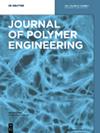Investigate the influence of GO as an additive in the silica-based polyethylene glycol shear thickening fluid on the rheological properties
IF 1.7
4区 工程技术
Q4 POLYMER SCIENCE
引用次数: 0
Abstract
Shear thickening fluids (STF) represent stabilized and concentrated colloidal suspensions, wherein hard nanoparticles are dispersed within a liquid medium (polymer). Under the influence of impact forces, they exhibit non-Newtonian behavior, effectively dissipating energy through shear thickening. The optimization of the dispersion medium’s viscosity is critical, as it not only fosters shear thickening but also facilitates proper particle dispersion. This study investigates the impact of graphene oxide (GO) as an additive in STFs, analyzing both static and dynamic rheological properties. STFs were formulated using colloidal silica particles (600 nm) and polyethylene glycol (PEG-200), with varied concentrations of GO particles (0.12–0.5 % w/W). The systems underwent comprehensive analysis concerning steady-state and dynamic-state rheological behavior under diverse conditions. The findings reveal that the inclusion of GO augments both static and dynamic rheological properties, reaching an apex at an optimal concentration of 0.36 % w/W. GO functions as a network builder within the STF, interacting with the existing particle network to create a more robust and interconnected structure. These enhanced properties underscore the potential of the synthesized STF for applications requiring impact resistance.研究 GO 作为硅基聚乙二醇剪切增稠液添加剂对流变特性的影响
剪切增稠流体(STF)是一种稳定的浓缩胶体悬浮液,其中坚硬的纳米颗粒分散在液体介质(聚合物)中。在冲击力的影响下,它们表现出非牛顿特性,通过剪切增稠有效地消散能量。分散介质粘度的优化至关重要,因为它不仅能促进剪切增稠,还能促进粒子的适当分散。本研究调查了氧化石墨烯(GO)作为添加剂对 STF 的影响,分析了静态和动态流变特性。采用胶体二氧化硅颗粒(600 nm)和聚乙二醇(PEG-200)配制 STF,并加入不同浓度的 GO 颗粒(0.12-0.5 % w/W)。对这些体系在不同条件下的稳态和动态流变行为进行了全面分析。研究结果表明,GO 的加入增强了静态和动态流变特性,在最佳浓度为 0.36 % w/W 时达到顶峰。GO 在 STF 中起着网络构建器的作用,它与现有的颗粒网络相互作用,形成了一个更加坚固和相互连接的结构。这些增强的特性凸显了合成 STF 在需要抗冲击性的应用中的潜力。
本文章由计算机程序翻译,如有差异,请以英文原文为准。
求助全文
约1分钟内获得全文
求助全文
来源期刊

Journal of Polymer Engineering
工程技术-高分子科学
CiteScore
3.20
自引率
5.00%
发文量
95
审稿时长
2.5 months
期刊介绍:
Journal of Polymer Engineering publishes reviews, original basic and applied research contributions as well as recent technological developments in polymer engineering. Polymer engineering is a strongly interdisciplinary field and papers published by the journal may span areas such as polymer physics, polymer processing and engineering of polymer-based materials and their applications. The editors and the publisher are committed to high quality standards and rapid handling of the peer review and publication processes.
 求助内容:
求助内容: 应助结果提醒方式:
应助结果提醒方式:


